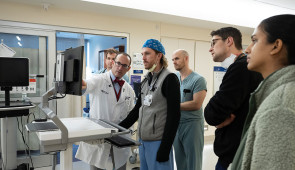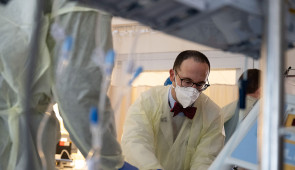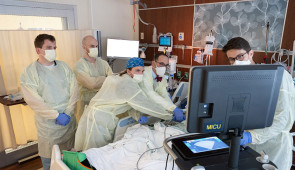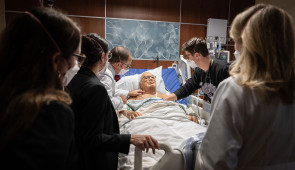- Doctors spend only 13% of their time (six minutes per patient) in direct contact with patients, leading to physician burnout and frustrated patients
- Most common error made in the physical exam is that the exam was never performed
- Center is building volunteer-patient program for medical trainees to practice authentic physical exams
CHICAGO --- The field of medicine is at a crossroads.
On one hand, artificial intelligence and advanced diagnostics are revolutionizing patient care. On the other, research has found that physicians — spread thin from electronic health recordkeeping and managing alerts — spend only 13% of their time in direct contact with patients, which translates to just six minutes per patient per day in the hospital. This often results in physician burnout and frustrated patients.
To combat this, Northwestern University Feinberg School of Medicine has launched a new Center for Bedside Medicine, which will aim to revitalize patient interactions by combining traditional elements of the bedside interaction — history taking, physical exam, clinical reasoning and more — with cutting-edge technology, such as artificial intelligence and point-of-care devices like digital stethoscopes and handheld ultrasound machines.
“We've lost sight of the importance of some of the traditional skills that still have value, like talking to and building a rapport with patients, doing a targeted physical exam,” said the center’s inaugural director Dr. Brian Garibaldi, a nationally recognized leader in innovative bedside teaching methods. “The most common error that's made in the physical exam is simply that the exam was never performed. Part of this is the false belief that if it's done through technology, it's somehow better than what we can see, hear, feel and smell.”
“We need to figure out how to layer on technology not to replace our time with patients but to make the most of the time we have with them,” said Garibaldi, also a professor of medicine in the division of pulmonary and critical care medicine at Feinberg and a Northwestern Medicine physician.
For instance, AI-trained ambient listening technologies can jot down notes during a physician-patient conversation, freeing up the doctor to focus on the patient and notice body language and other nonverbal cues.
“Part of what we’ll be doing at the center is reimagining what the clinical encounter looks like now that we have these emerging technologies while, at the same time, using traditional methods that still provide value,” Garibaldi said.
Garibaldi is a distinguished physician-scientist with expertise in clinical skills assessment, high-consequence pathogens, pandemic preparedness and COVID-19. He serves on the board of directors of, co-founded and was the inaugural co-president of the Society of Bedside Medicine.
The power of touch with real volunteer patients
Diagnostic errors are estimated to affect millions annually. They often stem from lapses in basic examination skills, which are hard to practice without hands-on patient contact.
“There are many times where patients will say, ‘No one's ever examined me in that way before,’ and it may be simply taking down someone's gown and listening to their chest or their back on their bare skin with the stethoscope and not through their clothes,” Garibaldi said. “When you listen through clothes, you are more likely to miss something.”
In the U.S., graduating medical trainees have not participated in real-patient assessments since the 1970s, which is different from elsewhere in the world (e.g. the United Kingdom), Garibaldi said. Instead, the U.S. medical system relies on multiple-choice examinations to test clinical knowledge. Medical schools assess physical exam skills in undergraduates by hiring actors who have been trained to mimic having a certain disease or set of symptoms. But there are limits to simulating a condition someone doesn’t really have. Direct observation of clinical skills with real patients is a rare event once doctors graduate from medical school.
To address this, the center is building up a volunteer-patient program called APECS (Assessment of Physical Examination and Communication Skills), which will fall under the center’s clinical teaching and assessment arm. This will allow real patients to come to the center to take part in clinical exams with trainees and share authentic results.
“In my own career, I've never had a directly observed assessment of my clinical skills,” Garibaldi said. “If we want to improve our clinical skills and see how technology can augment them, we need to assess those skills. With APECS, we can evaluate trainees’ skills and give them real-time, hands-on feedback.”
The center’s second arm will focus on research and innovation to help physicians and trainees keep up on what technology is available to supplement traditional methods. For instance, AI algorithms can use data from digital recordings of heart sounds, EKGs and ultrasounds to aid in diagnosing specific conditions, Garibaldi said. In the not-too-distant future, AI might even be able to use video recordings to make observations about specific diseases (e.g. spotting an abnormal gait as part of a neurologic illness). AI can already use video recordings from operating rooms to spot if someone in non-sterile gear has entered a sterile space.
Improving bedside manner and physician burnout
It's estimated residents and trainees are interrupted every few minutes by an electronic communication or by some alert, Garibaldi said. These interruptions keep physicians from thinking deeply about a particular issue and can make the patient feel ignored.
The center will aim to implement evidence-based methods to help physicians make the most of the limited time they have with patients. One way is getting trainees to feel more comfortable dealing with uncertainty during patient interactions.
“There’s a lot of uncertainty in medicine,” Garibaldi said. “When we're uncomfortable with uncertainty, we also tend to be less empathetic, more guarded. By observing trainees during interactions with real patients, we can help physicians navigate uncertainty, be more present during an encounter and develop meaningful connections with their patients.”
More about the center’s inaugural director
Prior to joining Feinberg, Garibaldi was professor of medicine and of physiology at the Johns Hopkins University School of Medicine and director of the Johns Hopkins Biocontainment Unit (BCU) — one of only 13 federally funded special pathogens treatment centers — which worked closely with the U.S. Administration for Strategic Preparedness and Response (ASPR) to create a National Special Pathogens System. Garibaldi was the clinical lead for the Johns Hopkins Coronavirus Resource Center and director of the Johns Hopkins Precision Medicine Center of Excellence (PMCOE) for COVID-19. When the president of the United States became ill with COVID-19 in October 2020, Garibaldi served as a member of the care team at Walter Reed Medical Center and the White House.






